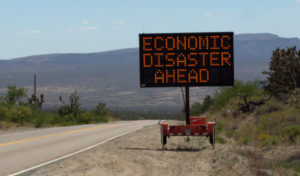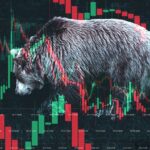
By Tilted Hat Productions @ Shutterstock.com
Harvard economics professor, Martin Feldstein, who presciently said the U.S. may be in recession back in March of 2008, is again warning that a recession may be looming. He writes at The Wall Street Journal:
The principal risk now is that a stock-market slowdown could shrink consumer spending enough to push the economy into recession. Share prices are high today because long-term interest rates are extremely low. Today the interest rate on 10-year Treasury notes is less than 3%, meaning the inflation-adjusted yield on those bonds is close to zero. The hunt for higher yields drives investors toward equities—driving up share prices in the process.
But long-term rates are beginning to rise and are likely to increase substantially in the near future. Though the 3% yield on 10-year Treasurys is still low, it’s still twice as high as it was two years ago. It will be pushed higher as the Fed raises the short-term rate from today’s 2% to its projected 3.4% in 2020. Rising inflation will further increase the long-term interest rate as investors demand compensation for their loss of purchasing power. And as annual federal spending deficits explode over the coming decade, it will take ever-higher long-term interest rates to get bond buyers to absorb the debt. It wouldn’t be surprising to see the yield on 10-year Treasurys exceed 5%, with the resulting real yield rising from zero today to more than 2%.
As short- and long-term interest rates normalize, equity prices are also likely to return to historic price-to-earnings ratios. If the P/E ratio of the S&P 500 regresses to its historical average, 40% below today’s level, $10 trillion of household wealth would be wiped out. The past relationship between household wealth and consumer spending suggests such a decline would reduce annual spending by about $400 billion, shrinking gross domestic product by 2%. Add in the effects on business investment, and this spending crunch would push the economy into recession.
Most recessions are short and shallow, with an average of less than a year between the start of the downturn and the beginning of the recovery. That’s because the Fed usually responds to recessions by cutting the federal-funds rate substantially. But if one hits in the next few years, the Fed will not have enough room to cut rates, as the fed-funds rate is expected to rise to only 3% by 2020. There also won’t be much room for a major fiscal intervention. Federal deficits are expected to exceed $1 trillion annually in the coming years, and publicly held federal debt is predicted to rise from 75% of GDP to nearly 100% by the decade’s end.
This means a downturn brought on in the next few years by rising long-term interest rates would likely be deeper and longer than your average recession. Unfortunately, there’s nothing at this point that the Federal Reserve or any other government actor can do to prevent that from happening.
Read more here.
Originally posted October 1, 2018.
E.J. Smith - Your Survival Guy
Latest posts by E.J. Smith - Your Survival Guy (see all)
- Your Survival Guy Breaks Down Boxes, Do You? - April 25, 2024
- Oracle’s Vision for the Future—Larry Ellison Keynote - April 25, 2024
- Investing Is Math - April 25, 2024
- Breaking: New Rules on Trillions in IRAs and 401(k)s - April 24, 2024
- When You’re in Control, You Have Opportunities - April 24, 2024















